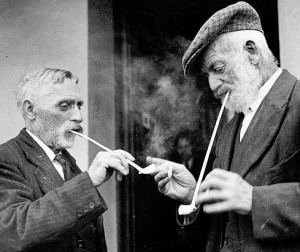 Bacca Pipes
Bacca Pipes
The Morris tune Bacca Pipes is being played here by Dr. Kenworthy Schofield on the Pipe and Tabor.
The name “bacca” is short for tobacco and the pipe referred to is the long, fragile, clay, churchwarden pipe.
Duration: 2 min.
“This tune [Green Sleeves] is a favourite with all Morris Dancers, and is always associated with the “bacca pipes” jig.” (Sharp 1909, p. 8) “This is traditionally a solo Jig: it may however be danced simultaneously by two or more performers” (Sharp ibid., p. 33) “A mistake [while dancing] 5 leading to the breaking of one of the pipes was, according to custom, penalized by the payment of the fine of a shilling, which was expended in the purchase of refreshment for the company. At Stow-in-the-Wold we were told that during the performance of this jig the fool used to run round amongst the spectators singing the following words:
Green sleeves and yellow leaves,
Boys and girls they work apace;
They earn some money to buy some lace
To lace the lady’s green sleeves.
We have taken down several variants of the air, four of which we have used in the four figures of the dance. It is worthy to remark that the seventh note of the scale in every one of our versions is flattened; whereas in all the printed copies we have seen, in Chappell and elsewhere, the seventh is sharpened. This is a good example of the way in which folk-tunes have, in the past, suffered at the hands of musicians.
Green Sleeves is the parent tune of many well-known airs, e.g., I saw three ships come sailing in, Dame get up and bake your pies, O shepherd, O shepherd, will you come home, &c. The second strain of the air is almost identical with that of The Rigs o’ Marlow, and it is also the basis of There’s nae luck about the house.”
(Sharp & Macilwaine 1909, p. 8-9)
♣ ♣ ♣ ♣
Dr. Robert Kenworthy Schofield (1901-1960) first became involved in English folk music and folk dance during the Peace Day celebrations of 1918, at the end of the First World War (1914-1918). At Cambridge University he joined the local branch of the English Folk Dance Society (EFDS) and became a founder member of “The Travelling Morrice”. It was on Morris tours in the Cotswold that he met some of the surviving traditional dancers and musicians. His notes about these encounters can be found in the EFDS Journals for 1928, 1930 and 1934. Later he was one of those responsible for the formation of “The Morris Ring”. Outside his music Dr. Schofield was a physicist who, after leaving Cambridge, worked at the Rothamsted Research Station in St. Albans. He was the author of a number of scientific papers.
